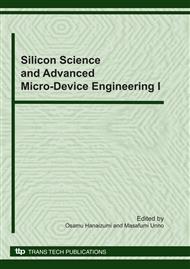[1]
M. Unno, S. Chang and H. Matsumoto: Bull. Chem. Soc. Jpn. Vol. 78 (2005), p.1105.
Google Scholar
[2]
M. Unno, Y. Kawaguchi, Y. Kishimoto and H. Matsumoto: J. Am. Chem. Soc. Vol. 127 (2005), p.2256.
Google Scholar
[3]
(a) T. Hiyama, In: Metal-Catalyzed Cross-Coupling Reactions, edited by F. Diederich and P. J. Stang Wiley-VCH, Weinheim, Germany (1998).
Google Scholar
[4]
M. Endo, T. Sakurai, S. Ojima, T. Katayama, M. Unno, H. Matsumoto, S. Kowase, H. Sano, M. Kosugi and K. Fugami: Synlett Vol. 5 (2007), p.749.
DOI: 10.1055/s-2007-970773
Google Scholar
[5]
Reactions using cyclic oligosiloxanes in which one aryl or vinyl group is attached to a silicon atom have been reported: (a) S.E. Denmark and C. R. Butler: Org Lett. Vol. 8 (2006).
Google Scholar
[6]
(a) E. Hagiwara, K. Gouda, Y. Hatanaka and T. Hiyama: Tetrahedron Lett. Vol. 38 (1997).
Google Scholar
[7]
Stronger bases such as t-butoxides, tetrabutylammonium hydroxide, and sodium hydride have also been employed for the same purpose: (a) S.E. Denmark and J.M. Kallemeyn: J. Org. Chem. Vol. 70 (2005).
Google Scholar
[8]
All the reagents examined were non-hygroscopic white powder, which could be kept under air at rt without obvious loss of the reactivity.
Google Scholar
[9]
Denmark has reported a quite atom-efficient vinylation system using hexavinyldisiloxane as the vinylating agent: S.E. Denmark and Z. Wang: J. Organomet. Chem. Vol. 624 (2001), p.372.
Google Scholar
[10]
(a) Nakao and Hiyama recently developed a reusable organosilicon reagent for cross-coupling reaction: Y. Nakao, H. Imanaka, J. Chen, A. Yada and T. Hiyama: J. Organomet. Chem. Vol. 692 (2007).
DOI: 10.1016/j.jorganchem.2006.04.046
Google Scholar


